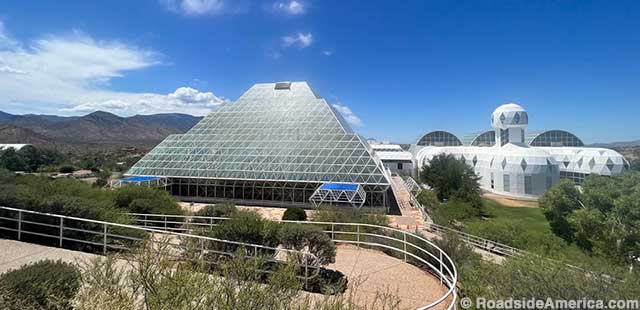
Biosphere 2 was built to replicate Biosphere 1, commonly known as the Earth.
Biosphere 2
Oracle, Arizona
Depending on your age and familiarity with science, the name "Biosphere 2" might bring to mind a hi-tech human fishbowl, or a research facility studying the effects of climate change. Or possibly a video game.
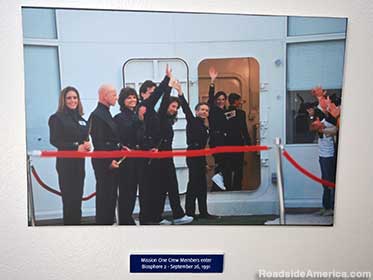
Biospherians enter the hatch in 1991, not to emerge until 1993.
Biosphere 2 is a geodesic greenhouse in the Sonoran Desert. With over seven million cubic feet underneath a spaceframe of metal and glass, it was designed to be a closed system, complete with its own mini-rainforest, farmland, and ocean: a second biosphere separate from Biosphere 1, commonly known as the Earth.
On September 26, 1991, eight volunteer "Biospherians" -- four men and four women -- entered Biosphere 2 and the hatches were sealed. For two years nothing was to come in or go out.
The experiment was the dream of John Polk Allen, self-described poet, playwright, activist, world traveler, and master of "biospherics." Allen's first foray into grand enviro-conscious living was with Synergia Ranch, a New Mexico counterculture commune inhabited by devotees of Spaceship Earth, producing "ecotechnic" products and ideas when not staging plays through their wandering troupe, the Theater of All Possibilities. Much of the staff involved with Biosphere 2 came from the Ranch.
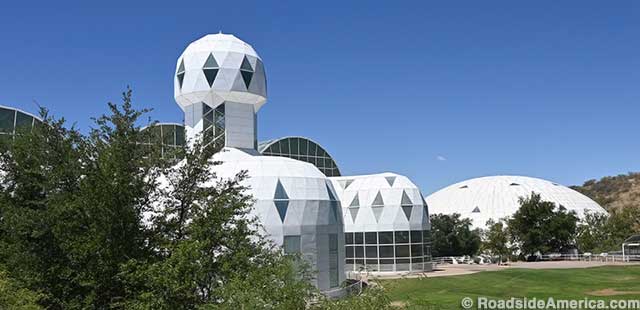
The living quarters of Biosphere 2 still look futuristic from the outside.
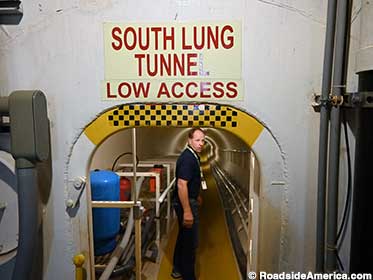
Winds inside the lung access tunnel can reach gale force.
Biosphere 2's knack for drawing media attention -- and its sci-fi-style jumpsuits -- had many detractors, who branded it too utopian and theatrical for true science. And the experiment did not go as planned. Oxygen had to be pumped in, members of the scientific advisory committee quit, ants were everywhere, and the eight-person crew suffered from infighting and hunger (Some even smuggled in snacks). After two years the Biospherians emerged alive, which was an accomplishment, but not the seismic scientific success that Allen had imagined.
Biosphere 2 subsequently went through a series of owners, with varying degrees of public accessibly. For a time there were fears that the building would be torn down. But over 30 years have passed and Earth's second biosphere is still standing, now under the stewardship of the University of Arizona. Tourists are welcome to visit, and free to leave whenever they want.
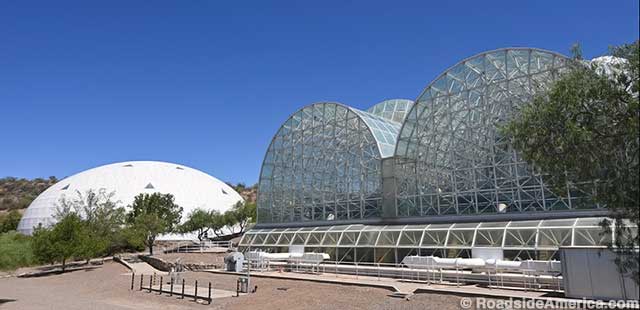
Biosphere 2's greenhouses were supposed to supply all the food needed for long-term survival.
"In my opinion it worked remarkably well," said John Adams, the facility's chief operations officer, who has been at Biosphere 2 since 1996. He informally calls the place "B2," and is tolerant of the building's awkward early years. "There were things that were not originally anticipated, so they had to tweak it," he said. "I mean, just look at our phones. How many iterations of software have we gone through? So, the same thing."
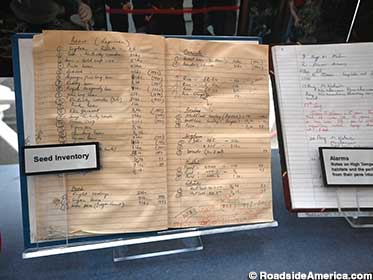
Hand-written daily logs record the monotony of the Biospherians' two-year ordeal.
The current facility continues to be active in research, and visitors mingle with student helpers and white-coated technicians. If you didn't know its history, you could easily guess that it was called something like Biosphere 2. Severe and angular, with acres of glass and geodesic struts, the building is a Hollywood retro-concept of what the scientific future would look like. Walking along the sterile hallways evokes images from The Andromeda Strain; looking out over the domed forest brings to mind Silent Running.
"We've left places in the upper habitat for historical interpretation, representative of what it was like when people were inside," said John. "We've got the dining table, the kitchen. We've left one of the original apartments as it was." Visitors can enter the building through the main airlock door and see the window through which the crew waved to the outside world. Photos line the hallways, showing the 1991 Biospherians as they performed their chores and picnicked on the artificial beach. Some of their hand-written daily logs are displayed, open to pages highlighting the monotony of the two-year ordeal.
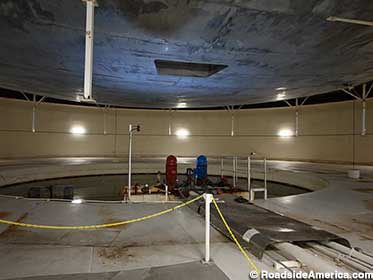
Inside the lung. Without it, air pressure would blow out Biosphere 2's glass walls.
"A lot of the comments that we get from visitors are, 'Well, why don't you put people back inside?,'" said John. "But to be honest, there are places now where you could do that and do a better job."
Today's self-guided tour at Biosphere 2 mostly emphasizes the science currently underway; there is much praise for its research into agrivoltaics, ocean acidification, and the global methane budget. The domed farmland that originally grew food for the too-hungry Biospherians is now a sloped landscape studying rainfall and other stimuli on ecosystems. "We are the world's largest controlled environment dedicated to understanding the impact of climate change," said John. Yet in keeping with the creators' ethos of interdisciplinary examination, student filmmakers and dance majors sometimes use Biosphere 2 as scenery, rather than as a research facility.
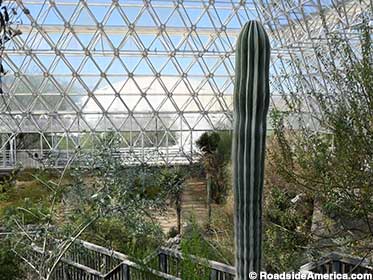
Biosphere 2 has its own desert, rainforest, and mini-ocean.
Visitors who want a more complete view of B2 can take an hourly guided tour of the underground systems that keep the facility running. It ends in one of the "lungs" -- large chambers deep inside Biosphere 2. The air enclosed within the building, cooled and contracted by night, heated and expanded by day, would blow out B2's glass walls without the lungs' giant rubber membranes to balance the air pressure. You'll appreciate this by walking down one of the lung access tunnels, where wind gusts can reach speeds usually only found at indoor skydiving attractions.
Biosphere 2 was built with "one day" in mind, whether that day be the aftermath of a nuclear holocaust, zombie apocalypse, or as the only viable living situation for a radically changed natural world. John gives the impression that B2's current caretakers view the original project as courageous, even if 21st century science would have done things a little differently. And while popular opinion mocked the Biospherians, in a later form they became a smashing success. A group of people thrown together, trying to survive a series of stressful challenges? It's the concept that made Reality TV possible.





